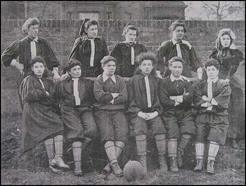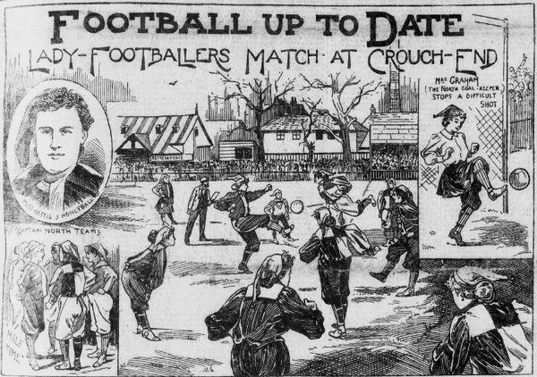 Did you realise that the connection between Tottenham Hotspur and women’s football dates back to 1895? With the Women’s World Cup about to take place and our ladies side doing so well. I thought we might take a look back at how the female game has grown since its earlier years and some of the problems they encountered. The story told over two parts starts with why women should be given free admission to games and advice to young men on how to choose a bride. There’s an eleven year old superstar, how to behave in church and a future Prime Minister. There is the question of is it healthy for young women to play the sport. Finally we discovered why it was banned.  From The Police Illustrated News From The Police Illustrated News The first women’s football seems to have occurred in Scotland. That’s ignoring the Church of Scotland’s records that state several women were barred from the church after being found kicking a ball between each other in the building. That goes back to the 1600‘s. Moving a little more up to date the 18th century and Scottish women arranged games as part of the local marriage customs. Games would be played between the married and the single women. Local bachelors would watch the game to assess possible brides. The earliest record of women’s football match dates back to 1881, (pre THFC). A game was advertised as between Scotland and England and took place in Edinburgh. Before the game the local press was not impressed. ‘So it has come at last! What next? ‘ Was the headline in Bells Life. ‘Several years ago there was a rage for silly displays of certain kinds of athletics by women, but we thought the time had passed, to give the arrangement the semblance of an international event the girls had the cheek to designate the farce England v Scotland.’ Afterwards they were little warmer, the Glasgow Herald claiming the ladies “were very suitably dressed and from a distance could not be distinguished from men”. It also stated they worn high heeled boots. The report however was concerned about the standard of play, claiming it was “of the most primitive order” and that it was “a humiliating spectacle”. For the record the home side won 3-0. Another game was quickly arranged the following week in Glasgow however the crowd became rowdy and in the second half invaded the pitch and ‘jostled’ the players who were forced to seek safety. This series of matches lasted seven games and the popularity faded. South of the boarder women did not become involved to much later. In April 1885 Preston North End were concerned about the behavior of the men attending their games they announced that male behaviour at games would be improved if they were accompanied by women. They therefore allowed them free admission to all their games. Its recorded that over 2,000 females attended some games. This free admission spread to other clubs and became so popular that the free admission was dropped and they were made to pay by the end of the 1890’s. As for participation, In 1894 Nettie Honeyball advertised for ladies to join the British Ladies Football Club. The club met under the patronage of Lady Florence Dixie. The idea was derided by the press and the Oval ground refused them permission to use the ground. However before long they were training twice a week at a ground in North London. Their trainer was Bill Julian who was at that time with Tottenham Hotspur. That top image is the North London side, Miss Honeyball is standing second left. Many of the ladies taking part used pseudonym's to avoid derision from people who knew them. The Daily Sketch reported “There was an astonishing sight in the neighbourhood of the Nightingale Lane Ground, Crouch End, on Saturday afternoon, Crouch End itself rubbed its eyes and pinched its arms. All through the afternoon train-loads of excited people journeyed over from all parts, and the respectable array of carriages, cabs, and other vehicles marked a record in the history of football.” The event was the British Ladies first public game. It was North V South London, the North won 7-1. The Daily Sketch informed the reader ‘The first few minutes were sufficient to show that football by women, if the British Ladies be taken as a criterion, is totally out of the question. A footballer requires speed, judgement, skill, and pluck. Not one of these four qualities was apparent on Saturday. For the most part, the ladies wandered aimlessly over the field at an ungraceful jog-trot. It would be idle to attempt any description of the play.” It summed up the event by saying “Football by women is totally out of the question.” The Manchester Guardian concerned itself more with what the ladies were wearing. "Their costumes came in for a good deal of attention, one or two added short skirts over their knicker-bockers. When the novelty has worn off, I do not think women's football will attract the crowds." The ladies did receive support from The Sportsman newspaper "True, young men would run harder and kick more strongly, but, beyond this, I cannot believe that they would show any greater knowledge of the game or skill in its execution. I don't think the lady footballer is to be snuffed out by a number of leading articles written by old men out of sympathy both with football as a game and the aspirations of the young new women. If the lady footballer dies, she will die hard." Even The British Medical Journal joined in the debate "We can in no way sanction the reckless exposure to violence, of organs which the common experience of women had led them in every way to protect."  Another reporter took up the question of what the ladies attire. "The orthodox jerseys were made the basis of the attire, but it was seen that a great deal had been left to the coquetry and taste of the wearers. In many instances they were made loose after the manner of blouses and were relieved at the edges by a little white embroidering. Some of the sleeves, too, were made extremely wide, being evidently made after a decidedly fashion-plate pattern. There was the same variety in the make of the knickers. This would seem to be a personal matter for the ladies themselves. Several of them probably more advanced in reformed dress ideas than their sisters, wore the lower garments in the ordinary football fashion." Whilst The Illustrated Police News, said “I went out of curiosity, and to see if the dear creatures were up to League form,' wrote the paper's correspondent 'Veteran', 'and I came away with the sad conviction that the proper place for the British Ladies' Football Club to exhibit their skill would be in the playground of a girls' school, and not in public.' Altogether not very encouraging for ‘the dear creatures’ it had however been a commercial success and over the next two years the club toured Britain playing over 100 games.
They also had a more sinister agenda, Miss Honeyball wanted to prove that the woman’s place wasn’t in the home and women were the equal of men. Some credit her with helping gain support for the suffragette movement and women's rights. Some sources suggest Miss Honeyball was itself a pseudonym, but given any leanings towards the suffragettes this is unlikely. Tomorrow in part 2 we look at what happened next, how the game developed and its demise. COYS Keith Harrison. ht54 t- Keith 16024542 f- peter shearman (old non de plume reserved for THFC matters)
0 Comments
Leave a Reply. |
Features
Flying Down to Rio History of T.H.F.C. Tribute to Bill Nicholson Talking Tottenham Early Legends The Road to Turin International Connections Hotspur Towers Most Read Articles
The 100 Year War Interview with Marina Sirtis A Long Dark Shadow By Royal Appointment School Report: An Insight into the Younger Eric Dier Dear Jimmy All Change At Spurs Hotspur Towers History Of THFC: Part 1 Passage to India: Rohan Rickets Thanks For The Memories Our Tommy Carroll The AVB Files: Part1 The Lilywhites You The Jury The Hand Of Hugo Connection - Argentina Creating a Reputation One Hotspur Archives
August 2018
Categories
All
|
 RSS Feed
RSS Feed

